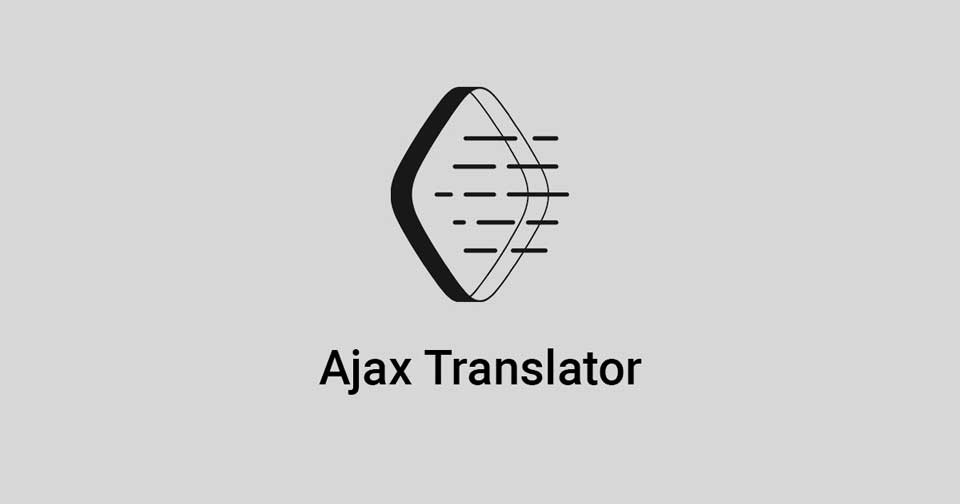Ajax Translator User manual, Ajax Translator is an app to establish communication between Ajax security systems and third-party monitoring software. Acting as a link between the hub and the Central Monitoring Station (CMS), Ajax Translator converts the notifications received from the hub into event protocol supported by the CMS software.
CMS software compatible with Ajax Translator
Ajax Translator receives events via the internet. In cities where internet connection is unstable, it is recommended to use VHF transmitters. The vhfBridge transponder is a module for connecting Ajax security systems to third-party VHF transmitters. It can be used as a primary or a backup communication channel.
Usefull Links :
- Danale Wireless Camera Installation Guide
- Elevate CMS Full User Manual
- UNV Viewing Playback and Clipping
How to get Ajax Translator
To get Ajax Translator, fill out the online form. If the form is filled out correctly, a link to the current version of Ajax Translator, login, and password for
authorization will be sent to your email address within 48 hours.
Your company will also be added to the Security Companies list in the Ajax app. This will allow you to receive user requests to connect security monitoring directly to Ajax Translator: the user selects your company from the list in the app, clicks Send monitoring request, and the request is automatically sent to the email assigned to the security company.
| Parameter | Minimum | Recommended |
| Processor | Intel Core I3 (2 cores) | Intel Core I5 (4 or more cores) |
| RAM | 4 GB | 8 GB |
| HDD | 128 GB free space | More than 128 GB of free space |
| OS | macOS Big Sur version 11.0.1 and later
Windows 7, 8, 10 |
|
| Java machine | A stable operation is guaranteed on version 7. Updates from 211 to 271 (Oracle) | |
| Network | 100 Mb/s | |
You can add no more than 5,000 objects from one account. If you service more than 5,000 objects, please create another account through our support team. You can service no more than 10,000 objects with one Translator, if the recommended system requirements are met.
Run the Ajax_Translator.jar executable and follow the instructions.
After installation, the Ajax Translator folder contains: clientSettings.properties — is a file with the default settings for Ajax Translator. advanced-virtual-com-port.zip, com0com (x86, x64).zip, vspd for example.exe — programs for creating virtual COM ports. Please note that these programs only run on Windows.
Translator app RU, Ajax Translator EN — Quick Start Guides for using the program in two languages in the PDF format.
The executable and other service folders:

| t | [3 > Ajax Translator v | c« | yP Search Ajax Translator | ||||
| Quick access
■ Desktop Downloads |
Name Date modified
L documents 7/22/2022 3:15 PM E log 8/9/2022 11:40 AM C settings 8/9/2022 4:03 PM |
Type Size
File folder File folder File folder |
|||||
| [§] Documents | |A>| Ajax_Translator 6/21/2022 4:21 PM | Executable Jar Hie 68,536 Kfi] | |||||
| Pictures | it | ||||||
Ajax Translator
log — the folder where Ajax Translator work logs are stored. If the program malfunctions, the data from this folder is sent to Ajax Systems Support Service for analysis.
settings — the folder where the Ajax Translator configuration file as well as database files with backups are stored.
Do not rename or change the location of folders and files inside the Translator Dist folder! This will lead to program malfunctions.
Ajax_Translator.jar — Ajax Ajax Translator application with the version number in the file name. To run the app, Java Version 7 Update from 211 to 271 (Oracle) must be installed on the computer. This can be downloaded from the official site.
Java does not support operating with COM ports. If connection with Ajax Translator via the COM port is needed, use Java 1.8 version.
Do not move the executable file! It should remain in the Translator Dist folder. Create a shortcut on the desktop for easy startup.
After running the Ajax_Translator.jar executable, you will see an account login window.
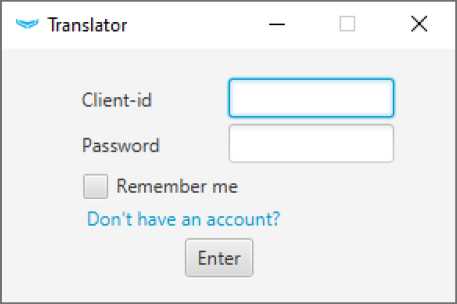
Copy and paste the login and password received from the Support Service. Use the Remember me option not to enter your user name and password each time the program starts.
For Ajax Translator autoload, create a shortcut for the executable file and configure autoload according to your operating system instructions.
How to update Ajax Translator
Ajax Translator version 1.8 and higher regularly checks the server for updates. If the program detects a new version, the Update button becomes active in the app.
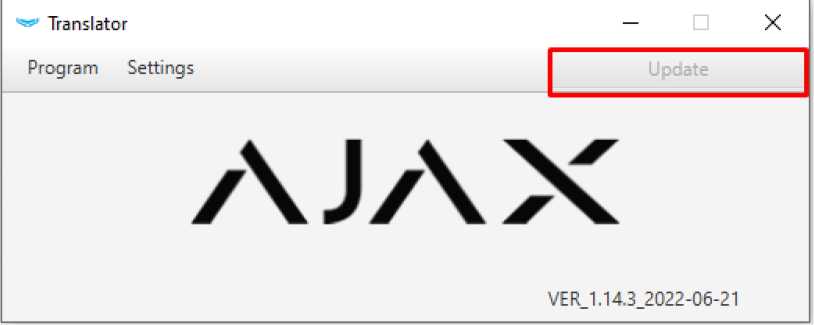
After clicking the Update button, the current version of the app is downloaded. As soon as downloading is finished, Ajax Translator displays a window with a prompt to install the update.
To install the update, you need to restart Ajax Translator. Install the update in the folder where the program is already installed.
If the Enable auto-login option is active, you will be offered 2 options: automatic and manual installation.
- When you choose automatic installation, the app shuts down and then updates automatically. The Ajax Translator starts again upon completion of the installation.
- If you choose manual installation, follow the instructions in the app to install the update. The Ajax Translator starts again upon completion of the installation.
If the Enable auto-login option is inactive, you can update Ajax Translator in manual mode only.
How to update the app if the Ajax Translator version is lower than 1.8
- Exit Ajax Translator.
- Download the actual version of the app here.
- Unpack the archive and run Ajax_Translator.jar. This is the installation file for Ajax Translator.
- Install the update following the installer instructions. Install the update in the folder containing the old version of Ajax Translator. This will save all linked hubs and program settings.
- Launch Ajax Translator.
All data transmitted by the hub is protected by block encryption with a dynamic key. Third-party console software cannot decrypt it independently. Ajax
Translator receives a message from the hub, decrypts it, converts it into standardized protocol messages, and translates it into CMS software.
Connecting Ajax Translator to CMS
Ajax Translator transmits messages through the event receiver of the Central Monitoring Station. You can configure communication with the CMS receiver via TCP/IP or via virtual/physical COM port.
Connecting via Socket (TCP/IP)
After you specify the server IP address and port in Ajax Translator settings, you will be able to transfer data both within the same computer (server) and on the local network or via the internet.
Before configuring Ajax Translator, you should create a new event source via TCP/IP in the event receiver of your CMS. When creating an event source, specify the port to which events will be transmitted from Ajax Translator in the Port field (the default value is 9292). In the Address field, leave the value 0.0.0.0 (localhost). This parameter changes if the computer has two or more IP addresses. In this case, you should specify which IP address and port the events will be received at CMS.
Option 1: Ajax Translator and event receiver on the same computer (server)
Launch Ajax Translator. Enter your user name and password, and click Enter. If you have specified the localhost IP address and port 9292 when configuring the event receiver, Ajax Translator will start immediately, since these values are set by default.
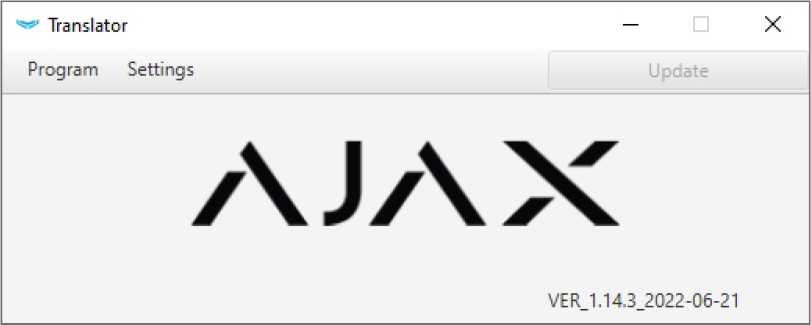
If another port or IP address has been specified in the event receiver or in Ajax Translator settings, a window with a “Failed to connect to Socket port” error will be displayed with the port number and IP address to which Ajax Translator was trying to connect.
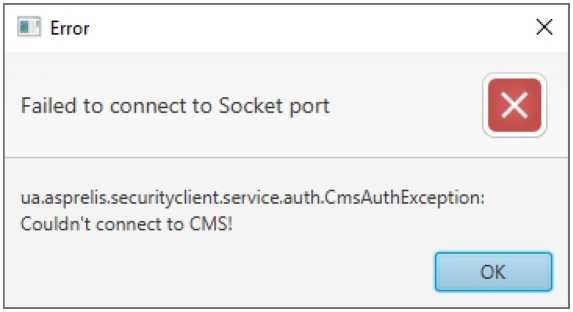
In this case, click OK to proceed to configure them. In the window that opens, enter the port number and IP address that were specified when creating the event source, click Save, and then OK.
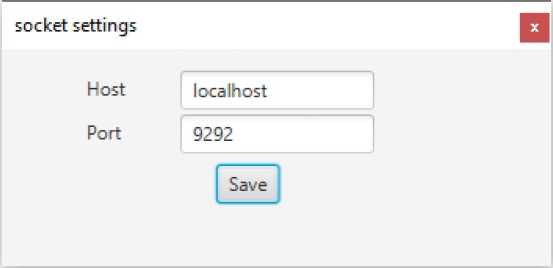
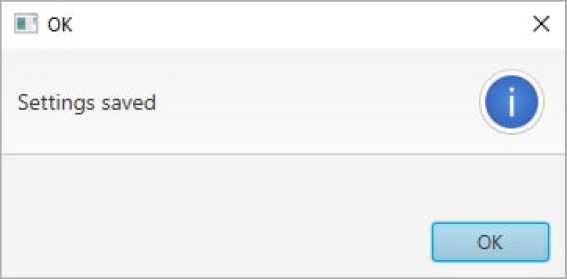
After the settings are saved, the login and password entry window will be displayed.
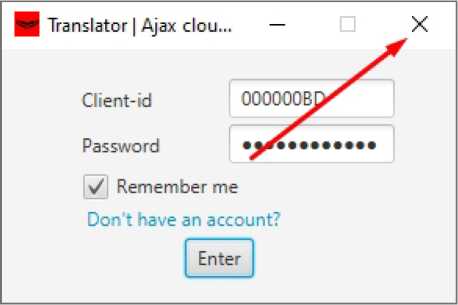
 Important: at this stage, close the program by clicking on the cross in the upper right corner to apply the settings. If you click the Enter button, Ajax Translator will not apply the settings and you will not be able to start the program again.
Important: at this stage, close the program by clicking on the cross in the upper right corner to apply the settings. If you click the Enter button, Ajax Translator will not apply the settings and you will not be able to start the program again.
If Ajax Translator was closed correctly, TCP/IP connection will be established during the next startup.
Option 2: Ajax Translator and event receiver on the same local network
If Ajax Translator and the event receiver are installed on different computers but on the same local network, the event receiver is configured the same way as described in the previous option, while Ajax Translator configuration is different.
When starting, Ajax Translator will return an error of failed connection to the Socket port. Click OK to go to the settings.
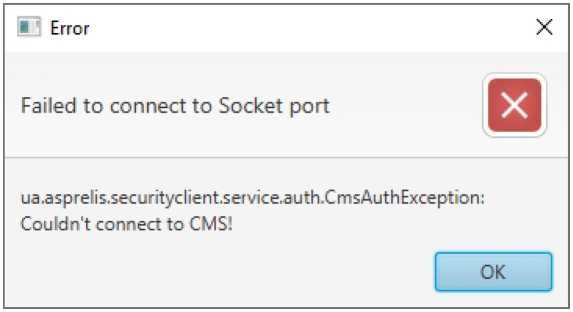
In the window that opens, specify the IP address of the computer (server) on which the CMS event receiver is installed in the Host field. Also indicate the port number if other than 9292. Click Save, then OK.
![]()
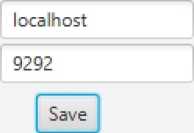
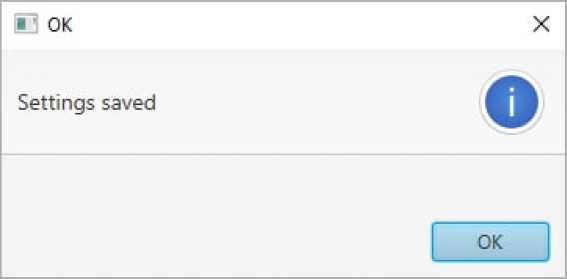
Host
Port
socket settings
After the settings are saved, the login and password entry window will be displayed.
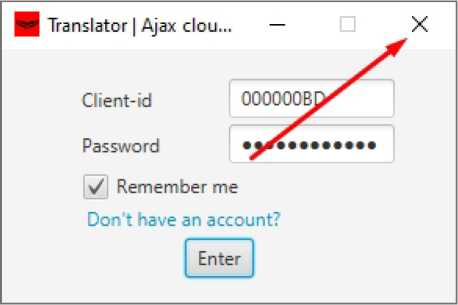
Important: at this stage, close the program by clicking on the cross in the upper right corner to apply the settings. If you click the Login button, Ajax Translator will not apply the settings and you will not be able to start the program again.
If Ajax Translator was closed correctly, TCP/IP connection will be established during the next startup.
If Ajax Translator and CMS event receiver are installed on the same computer (local server), they can be connected via a pair of virtual COM ports. You can also connect separate computers through two physical COM ports.
Before you configure the connection through the COM port, make sure you change the default connection settings of Ajax Translator.
 Changing Ajax Translator default connection settings
Changing Ajax Translator default connection settings
CMS connection via TCP/IP is installed in Ajax Translator by default. You can change the connection parameter in the Ajax Translator configuration file.
Make sure that Ajax Translator is not currently running.
Open the folder with Ajax Translator files, go to the Translator Dist folder and then to the Settings folder.

Ajax Translator
Open the clientsetting file using the default Notepad application.
| □ । a | v settings | – | □ | X | |||
| 1 Fiie 1 | Home Share View | ‘ O | |||||
| <- | * T l~l > Ajax Translator > settings | V | 0 | /D Search settings |
| Name | Date modified | Type | Size | |
| Quick access
H Desktop Downloads |
backup sen pts | shareware | 8/9/2022 11:45 AM
7/22/2022 3:15 PM ~UWiS22.3:15 PM |
File folder
File folder File folder |
|
| 4 Documents | * I clientSettinqs.properties | _ 8/9/2022 2:44 PM | PROPERTIES File | 2 KB |
| [B] Pictures
Ajax Translator |
* @ HubsDB.mv
* |
8/9/20222:44 PM | Data Base File | 16 KB |
Search for the string senderType = SOC and replace the “SOC” with “COM”.
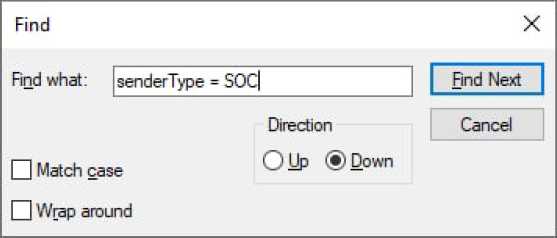
![]()
♦SOKET SETUP
♦SOKET SETUP
♦SENDER SWITCH “SOC” or “COM” senderType = SOC
♦SENDER SWITCH “SOC” or “COM” senderType = COM
♦Host socketHostname – localhost
♦Host socketHostname = localhost
♦port socketPort = 9292
♦port socketPort = 9292
♦Period in minutes of connection to ke< minutes)
♦Period in minutes of connection to keep minutes)
Make sure you save the file. Go to the File menu and click Save.
U ‘clientSettings – Notepad
File Edit Format View Help
New CtrkN
New Windaw CtrkShift*N
Open… CtrkO
Save Ctrl *5
Save At.. CtrkSbift*S
Page Setup…
Print,. CtrkP
Exit
Before you configure Ajax Translator, create a pair of virtual COM ports. Any emulator, for example, com0com, is suitable for creating virtual COM ports. Emulator setup instructions are available from the developer.
Specify one virtual port as the event source in the event receiver of your CMS and the other port in the settings of the CMS Connection menu in Ajax Translator.
Setting up virtual COM ports
After changing the configuration file and creating the virtual COM ports, launch Ajax Translator. Enter your user name, password, and click Enter. Use the Remember me option to not enter your user name and password each time the program starts.
Connection via COM port 3 is established by default in Ajax Translator settings. If your computer has a COM port with this number and it is not busy with any processes, Ajax Translator will connect to it and start. For correct transmission of events to the CMS, change COM settings in Ajax Translator settings and indicate the number of the virtual port you have created: Setting —> CMS Connection —> COM Settings —> Specify COM Port.
If your computer does not have a COM port with this number or the port is busy with another process, the message “Connection to COM port failed” will be displayed.
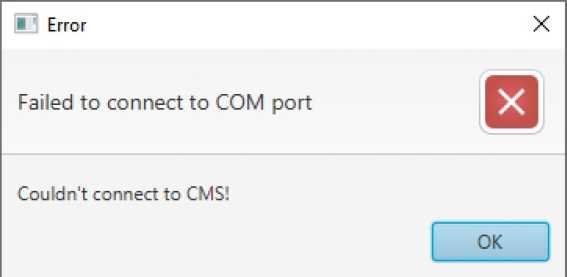
Click OK to configure the COM port settings.
![]()
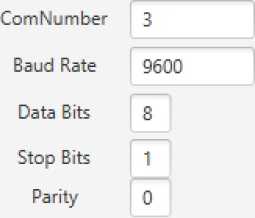
com port settings
Save
In the window that opens, the following settings will be available:
- ComNumber — COM port number to which data will be transmitted
- Baud Rate — data transfer rate
- Data Bits — data bits
- Stop Bits — stop bits
- Parity — parity control
Enter the number of the other COM port from the previously created pair in the ComNumber field, click Save, and then OK.
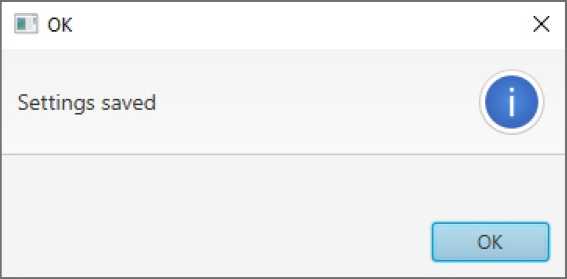
 The remaining Baud Rate, Data Bits, Stop Bits, and Parity settings shall match the settings on the CMS side.
The remaining Baud Rate, Data Bits, Stop Bits, and Parity settings shall match the settings on the CMS side.
After the settings are saved, the login and password entry window will be displayed.
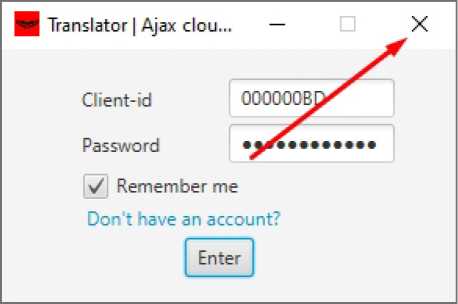
 At this stage, close the program by clicking on the cross in the upper right corner to apply the settings. If you click the Enter button, Ajax Translator will not apply the settings and you will not be able to start the program again.
At this stage, close the program by clicking on the cross in the upper right corner to apply the settings. If you click the Enter button, Ajax Translator will not apply the settings and you will not be able to start the program again.
If Ajax Translator has been closed correctly, connection via the COM port will be established the next time you start.
The Ajax Translator settings menu is located in the Settings tab:
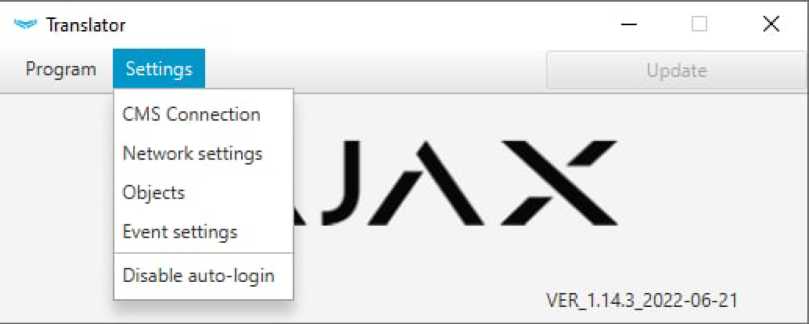
| CMS connection | Configuring the CMS connection settings. |
| Network | Configuring the Ajax Cloud server connection settings. |
| Objects | Menu for adding/removing protected objects and linking them to CMS object numbers. |
| Events | Menu for editing event codes sent to CMS. |
The CMS connection setup menu consists of the following blocks:
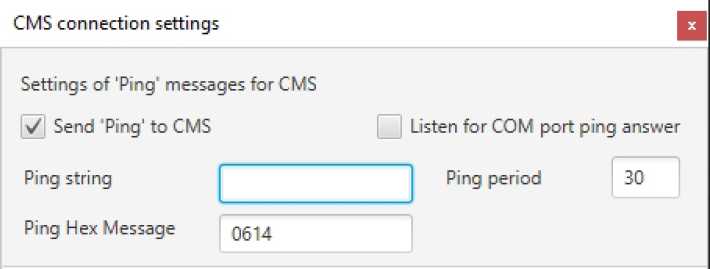
The Settings of “Ping” messages for CMS block is responsible for periodically checking the connection between the CMS and Ajax Translator (it should be configured on the CMS)
Send “Ping” to CMS turns on/off sending of test messages
Ping String — configuration of the string to be sent to CMS
Ping HEX Message — the code of the verification message sent
HEX message is in hexadecimal format (converted to text in the log). For example, HEX message 4444 will be shown as DD. HEX should be used to display ASCII characters and extra spaces at the end of a ping message.
Ping Period — sets the frequency of sending test messages in seconds
Listen for COM port ping answer — an option to control the event reception by your CMS
Type of connection to CMS
• Socket
Show connection settings
■/ Wait for CMS message ackno…
COM Port
The Type of connection to CMS block allows configuring the connection between CMS software and Ajax Translator via TCP/IP or COM port.
To connect via TCP/IP, disable Wait for CMS message acknowledgement. In this case, Ajax Translator will not wait for a response to the event sent. When connected via a pair of COM ports, Ajax Translator always expects CMS message receipt confirmation. If Ajax Translator does not receive confirmation, it reports that there is no communication with the CMS.
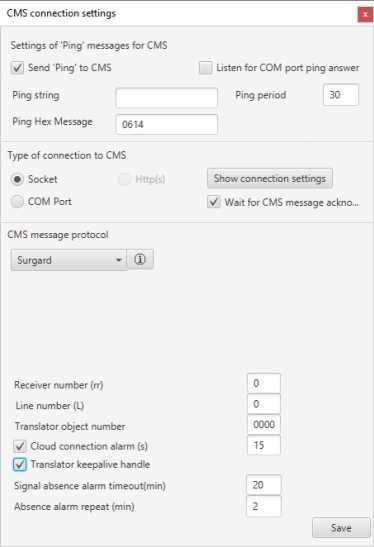
The CMS Message Protocol block is designed to configure the event transmission protocol. It contains:
- Protocol selection drop-down menu.
- Descriptive block with protocol decryption.
- Receiver number — sets the number of the event receiver. The default value is 00.
- Line number — sets the line number of the event receiver. The default value is 0.
- Translator object number — object number assigned to Ajax Translator, which can be used to control CMS communication.
- Cloud connection alarms — sets the communication absence time (in seconds) after which the CMS will receive a notification on loss of communication between Ajax Translator and Ajax Cloud.
Ajax Translator
- Translator keepalive handle — enables/disables test messages that are used to verify Ajax Translator hub connection. This also sets their frequency (in minutes).
Two options are available in Ajax Cloud server connection settings: Host and Port.
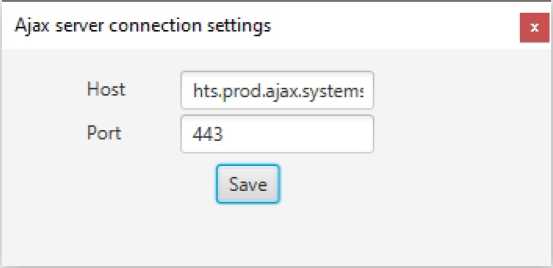
Ajax Translator works with DNS over port 443 (by default). All traffic going over this port is encrypted. To ensure the correct operation of Ajax Translator, you need to allow all traffic types on the 443 port.
The address for connecting Ajax Translator is hts.prod.ajax.systems.
If there is no internet connection on the computer, Ajax Translator will generate an error as follows:
“If you have internet connection but the message still appears, check Translator settings in the Network menu.”
The Objects menu consists of two tables and allows administering hubs connected to CMS. The table on the left shows the hubs from which users have sent a monitoring request through the Security Companies tab in the Ajax app. The table on the right shows the binding of hub IDs to CMS object numbers.
If the monitoring request was sent for the first time, then the Status line opposite the hub ID displays Not confirmed status. If the hub has already been linked to the CMS object number, the status is Confirmed. If the user has canceled the monitoring request in Ajax application, the status will be indicated as Waiting for removal.
![]()
![]()
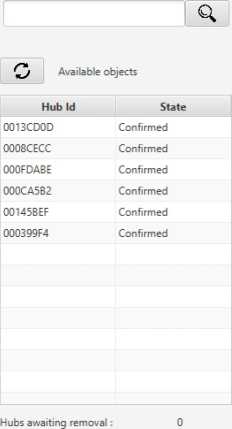
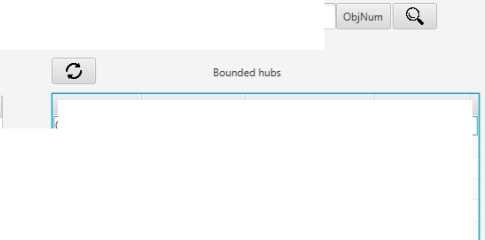
![]()
![]()

Objects menu
| Hub Id | Object num | State | cloud sync |
|---|---|---|---|
| 000399F4 | 0 | Bea hom. o6i>eKTa | OK |
| 0008CECC | 0 | Bes hom. obterra | OK |
| OOOFDABE | 0 | Bea hom. o6″beKTa | OK |
| 00145BEF | 123 | He ami Be h | OK |
| 0013CD0D | 2 | AtCTklBEH | OK |
| 000CA5B2 | 45 | Akthbeh | OK |
Artrvp Hubs;:
Add to active
The hub can be found in the list of objects by object number or by hub ID. To correctly search by hub ID, always enter Latin characters in the UPPER case.
By default, the search is performed by object number. To find the hub, enter the object number in the field and click Find:
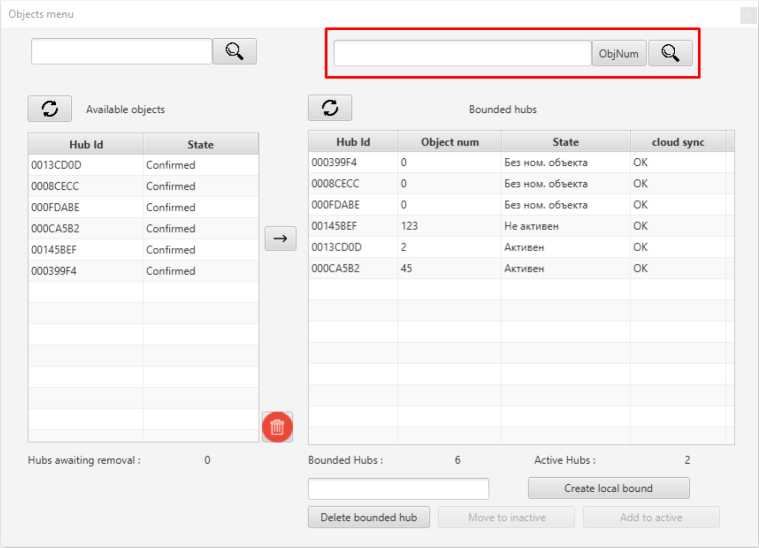
To search by hub ID, click the ObjNum button — its name will change to HubId, enter the hub ID in the search field, and click Search.
Termination of object monitoring
To suspend receiving events from an object, click on it in the table on the right and then click Move to inactive. The status of the object will change to Inactive, and the object will be displayed at the end of the list. To resume receiving events from the hub, click Add to active.
![]()
![]()

![]()
![]()

Objects menu
000399F4
0013CD0D
Confirmed
0008CECC
0008CECC
Confirmed
000FDABE
OOOFDABE
Confirmed
00145BEF
OOOCA5B2
Confirmed
0013CD0D
00145BEF
Confirmed
000CA5B2
000399F4
Confirmed
□e3 hom. ooteicra
z>e3 hom. o6″beKTa
□es hom. obteKia
Hubs awaiting removal:
He arrMBeH
Bounded Hubs:
To discontinue monitoring an object, remove the hub from Ajax Translator: select the hub in the right table and click the Delete bounded hub button.
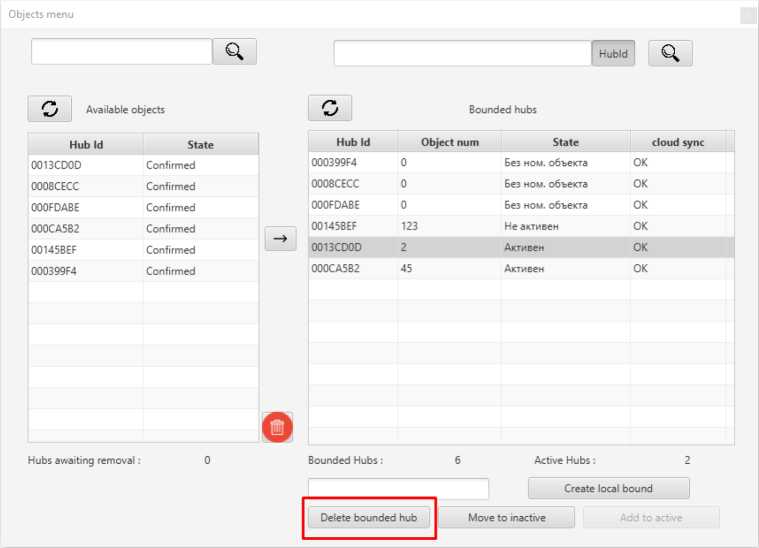
Then select the hub in the table on the left and click the trash icon.
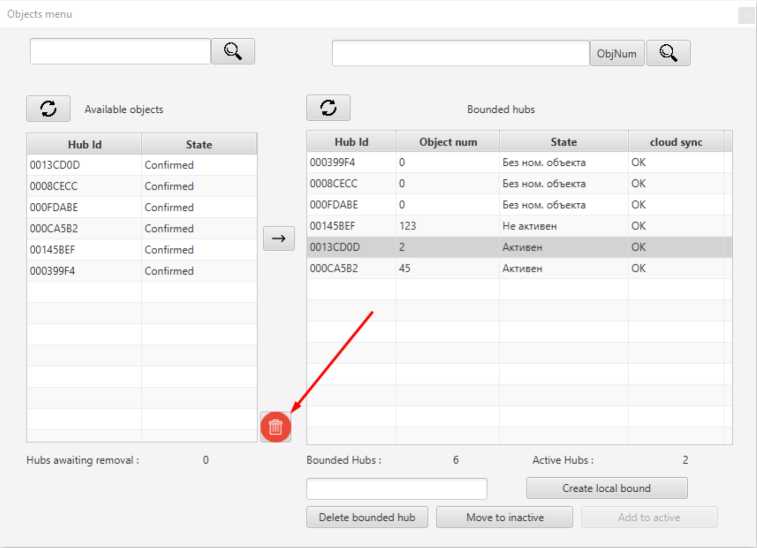
The Events menu allows you to edit event codes. Ajax Translator can transmit the following types of events to CMS:
- Alarms: fire, emergency, security, general, non-security, keyboard, tamper, visual verification (only SIA DC-09 (ADM-CID), Sentinel, Kronos, Manitou, Listener, MASXML and SBN)
- Malfunctions
- Communication problems
- Periodic tests
- Arming and disarming
- Pressing the panic button in the Ajax app (along with coordinates)
Translator app allows changing the default event codes (Contact ID). For example, your CMS uses the E725 code to report loss of communication with the central unit, and the hub sends the E350 code. In order not to change the CMS settings, edit the code in Ajax Translator. This feature is supported by all protocols with the events that can be sent via Ajax Translator.
SurGard (Contact ID) event codes
Go to the Events menu.
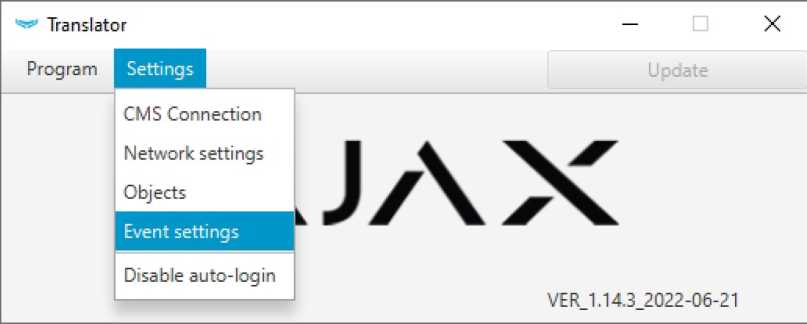
In the Replace what field, enter the code that requires adjustment, in the Replace to field, enter the new code, and click the Add button.
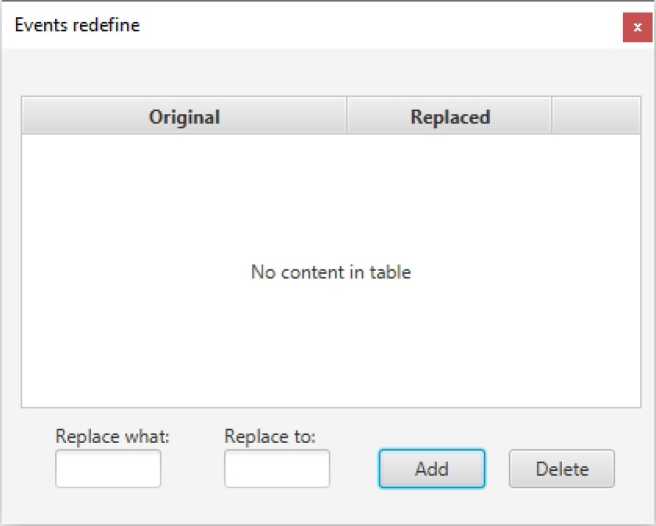

You cannot edit the rules for replacing event codes. If the rule is not relevant, delete it.
To delete an irrelevant rule, enter the code to be deleted in the Replace what field and click the Delete button. After correct deletion, you will receive a notification as follows.
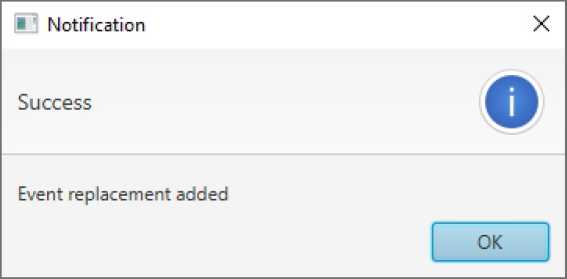
Configuring the filter of events transmitted to the CMS
Ajax Translator can send only certain hub events to the CMS. Therefore, you can configure the transmission of fire alarms only, without receiving notification of any other events.
- Go to the folder where Ajax Translator is installed.
- Go to the Settings folder and open the clientSetting.properties file using the standard Notepad application or a similar text editor.
- Add acceptableCodes = XXX; to the end of the file.
XXX — is the code of the event that you do not want to receive at the CMS. Do not use the E or R prefix. Note that the code must be followed by a semicolon (;). To specify several codes, separate them by a space.
An example of a line with one code: acceptableCodes = 111;
An example of a line with several codes: acceptableCodes = 111; 112; 113; 130;
Ajax Translator event transfer protocols
Ajax Translator supports protocols for transmitting events to CMS:
• transmission the coordinates of the panic
button pressed in the Ajax app
| • SurGard (Contact ID template) | • alarm and event transmission |
| • SurGard (Contact ID) Extended | • alarm and event transmission |
| • ABsistemDC(NG)v2 |
|
| • Patriot Systems |
|
| • Manitou |
|
| • SBN |
|
| • Sentinel |
|
| • SOFTGUARD |
|
| • Kronos |
|
| • MASXML |
|
| • Listener |
|
| • ADEMCO 685 | • alarm and event transmission |
Visual alarm verifications are transmitted through the Ajax Cloud server. When a direct connection is used (bypassing the server), a series of photos from MotionCam/MotionCam Outdoor will not be sent to the CMS. In this case, the photos will be transmitted to Ajax apps, including PRO Desktop (if the app is used).
Event transmission via SIA DC-09 (ADM-CID) protocol
Event transmission via SurGard (Contact ID) protocol
Event transmission via MANITOU protocol
Event transmission via SBN protocol
Event transmission via the Sentinel protocol
Event transmission via the SOFTGUARD protocol
Event transmission via the Kronos protocol
Event transmission via the MASterMind protocol
Event transmission via the ADEMCO 685 protocol
Connecting the hub to Ajax Translator
Communication between the hub and CMS software can be configured:
- via the Ajax Cloud server
- directly (bypassing the Ajax Cloud)
- directly and via Ajax Cloud at the same time
Use both communication channels to provide a more stable connection with the CMS.
How to connect a hub via Ajax Cloud
To connect the hub via a cloud server, the user with administrator rights should send a monitoring request by selecting a security company in Ajax application (Hub —> Settings —> Security Companies —> Select a company —> Send monitoring request). After that, the hub ID will appear in the list of available objects in Ajax Translator (table on the left).
To bind the hub to the CMS object number, highlight the hub ID in the table on the left and press the arrow button. The hub will be added to the table on the right with console number 0.
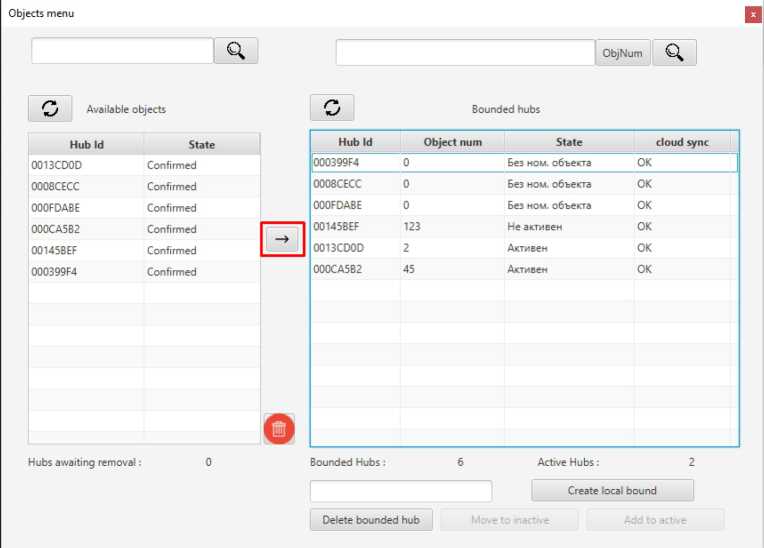
Double-click the cell in the Object No. column in the row of your hub in the table on the right. Write a free number to the object and press Enter on the keyboard. The object number should be within the range of 1 to 9999. If you enter a number of more than one character, do not put zeros in front of the object number: use “1” instead of “0001”.
![]()
![]()
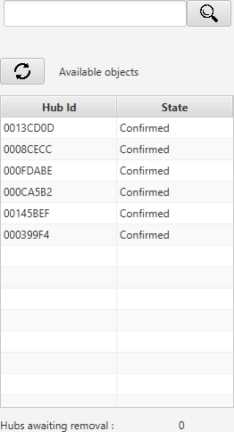
![]()
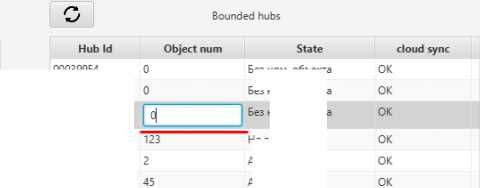
![]()
![]()

Objects menu
000399F4
0008CECC
OOOFDABE
hom. o6i»eKTa
00145BEF
He aKTMEeH
0013CDOD
AKTMBeH
ODOCA5B2
AtTWBeH
□es hom. ooteicTa
z>e3 hom. obteKTa
Active Hub1;:
Add to active
If you change the number and fail to press Enter, the hub will not be added to CMS. After successful binding, the Status line changes to Active.
In CMS software, create an object with the number matching the number assigned to the hub number in Ajax Translator.
How to connect the hub directly
Before you start connecting the hub to Ajax Translator bypassing the Ajax Cloud server, forward any external TCP port to internal port 3060. This way you provide an external static IP address for connection.
If the required port is busy, make changes to the Ajax Translator configuration file.
Open the folder with Ajax Translator files, go to the Translator Dist folder and then to the Settings folder.

[2i Ajax Translator
[2i documents
J) Music
H Videos
Open the clientsetting file using the default Notepad application.

![]()
| Name | Type | Size | ||
| jt’ Quick access H Desktop | backup scripts | 8/9/2022 11:45 AM
7/22/2022 3:15 PM |
File folder
Ale folder |
|
| Downloads X
4j Documents it |
shareware | 7/22/2022 3:15 PM
8/9/2022 3:42 PM |
File folder
PROPERTIES File |
2 KB |
| Pictures | f comOcom (x86,x64) | 4/1/2022 6:38 PM | Compressed (zipp… | 463 KB |
| Ajax Translator f | @ HubsDB.Iock | 8/9/20224:13 PM | Data Base File | 1 KB |
| documents
Music |
R HubsDB.mv | 8/9/20224:13 PM | Data Base File | 20 KB |
yi Videos
Search for the line directConnectPort = 3060 and replace “3060” with the free port value.
.J] dwtSertings-propertiet – Notepad — □ X
File Edit Format View Help
^UPDATE CHECK INTERVAL ^interval in minutes checkUpdateInterval – 1
^DIRECT CONNECT PARTNER PORT directConnectPort ■ 3060
#PP RECEIVER
PP – 0
#L LINE NUMBER
LineNumber – 0
i±nh. harhin i rttaru,/□ 1
Ln 1, CoM 100% Windows {CRLE) UTF-&
Make sure you save the file. Go to the File menu and click Save. Then restart Ajax Translator.
| clientSettings – Notepad | ||
| File | Edit Format View Help | |
| New Ctrl-i-N
New Window Ctrl+Shift -nN Open,,, Ctrl+O |
TO PING TEXT prefix 3e used | |
| Save Ctrl 4-S | ||
| Save As… Ctrl+Shift+S | ||
| Page Setup…
Print… Ctrl+P |
||
| Exit | ||
baudRate = 9600
dataBits = 8
<;+r>nRi + <; = 1
After configuring the connection from the CMS side, go to the Monitoring Station menu in the hub settings in the Ajax app. Indicate the IP address and the number of the forwarded external TCP port. Select the communication channels through which the hub will connect to your server: Ethernet and/or GPRS.
If only the GPRS channel is used for communication, activate the Ignore network registration errors in the cellular data settings.
(Hub —> Settings —> Cellular data)
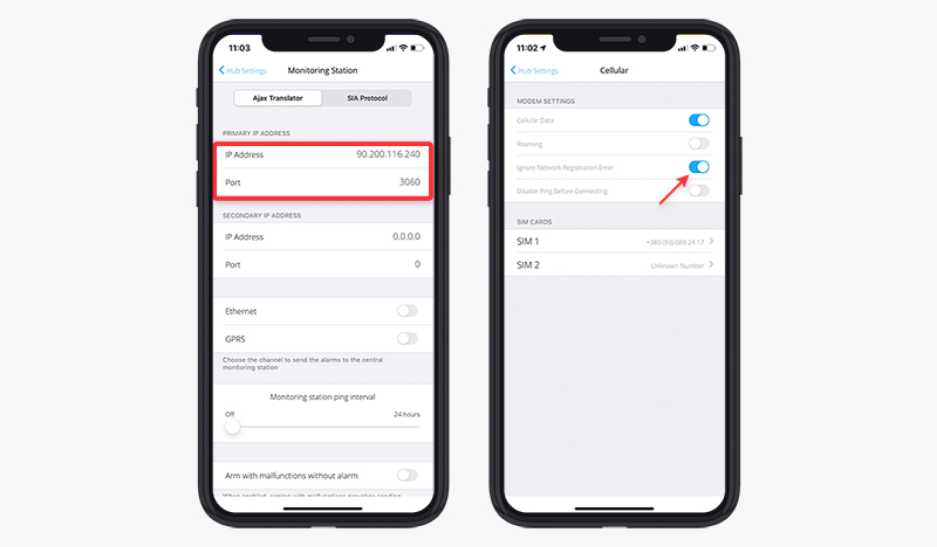 After configuring the connection between the hub and Ajax Translator via the TCP port, bind the hub ID to the CMS object number.
After configuring the connection between the hub and Ajax Translator via the TCP port, bind the hub ID to the CMS object number.
Go to the Objects menu in Ajax Translator, enter the eight-digit hub ID in the input field, and click the Create local bound button.
![]()
![]()

![]()
![]()
![]() Objects menu
Objects menu
000399F4
=es hom. ooteicra
0013CD0D
Confirmed
0008CECC
Sea hom. o6‘beKTa
0008CECC
Confirmed
OOOFDABE
Ses hom. oftbeicra
OOOFDABE
Confirmed
00145BEF
He atTMBeH
OOOCA5B2
Confirmed
0013CD0D
AtTHBeH
00145BEF
Confirmed
OOOCA5B2
AtTWBeH
000399F4
Confirmed
Hubs awaiting removal:
Bounded Hubs:
6
Active Hubs;
2
Delete bounded hub
Move to inactive
Add to active
The hub ID can be seen in Ajax app: go to the Devices tab, click on the hub, and go down the screen.
O Ethernet Connected
Ajax Hub 2
FW V2.8.3, HW 81.0.10.10.2.3.1.0, ID 000 3C
After you click the Create local bound button, a notification should appear.
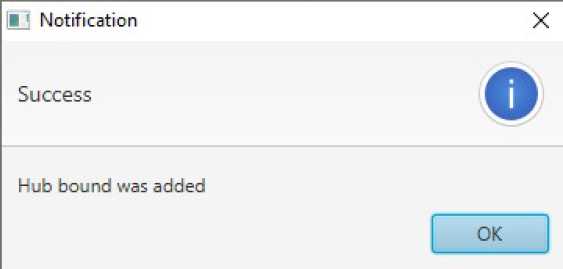
The hub will be added to the table on the right with console number 0. Doubleclick the cell in the Object No. column in the row of your hub in the table on the right. Write a free number to the object and press Enter on the keyboard.
How to connect the hub directly and via Ajax Cloud
To connect the hub via two communication channels at the same time, follow the connection procedure via Ajax Cloud and then configure direct connection as described in this manual.
The priority of direct connection is higher than the cloud server connection. If direct connection fails for any reason, Ajax Translator starts receiving events from the hub via Ajax Cloud. This way you can provide more stable monitoring of the protected object.
